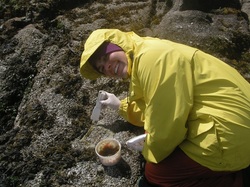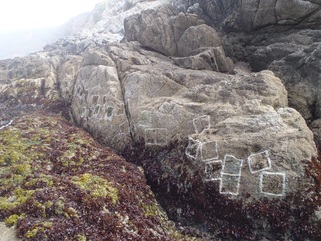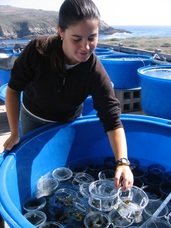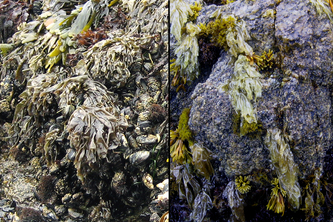Ecology, Biodiveristy, and Ecosystem Functioning
Research examining the effects of and the mechanisms maintaining diversity has remained largely distinct; however, there is continuously growing appreciation for the potential for interaction between unidirectional effects on communities. My dissertation work in the UC Davis Population Biology Graduate Group under the mentorship of Jay Stachowiz focused on the interactions between causes and consequences of biodiversity to generate a clearer picture of the relative importance of different factors influencing biodiversity and the degree to which feedbacks might exist.
The rocky shore along the California coast provides an ideal system in which to conduct studies of biodiversity because it contains a diverse assemblages of primary and secondary producers at a range of abundances. Furthermore, studies in the rocky intertidal zone have been a foundation of modern community ecology and much of this work has focused on the maintenance of species diversity. A few projects relating to my dissertation work follow.
The rocky shore along the California coast provides an ideal system in which to conduct studies of biodiversity because it contains a diverse assemblages of primary and secondary producers at a range of abundances. Furthermore, studies in the rocky intertidal zone have been a foundation of modern community ecology and much of this work has focused on the maintenance of species diversity. A few projects relating to my dissertation work follow.

How do herbivores interact with existing algal diversity to affect algal recruitment and succession?
[link to manuscript]
Many experimental studies have demonstrated that herbivores mediate the distribution and abundance of algae on emergent substrate in the rocky intertidal zone. These studies, however, typically examine effects of herbivores on cleared substrate without regard to the composition of the surrounding community. We conducted a field experiment crossing monocultures and polycultures of four common high-intertidal algal species with two herbivore treatments (ambient and reduced abundances) to measure their effects on algal recruitment and succession. We found that both the presence of herbivores and high surrounding algal richness increased recovery rates, and the effect of algal richness was twice the magnitude of that of herbivores. Our results suggest that herbivory and species richness should jointly accelerate recovery wherever palatable species inhibit late-successional, herbivore-resistant species and recruitment and survival of new colonists is promoted by local species richness.
[link to manuscript]
Many experimental studies have demonstrated that herbivores mediate the distribution and abundance of algae on emergent substrate in the rocky intertidal zone. These studies, however, typically examine effects of herbivores on cleared substrate without regard to the composition of the surrounding community. We conducted a field experiment crossing monocultures and polycultures of four common high-intertidal algal species with two herbivore treatments (ambient and reduced abundances) to measure their effects on algal recruitment and succession. We found that both the presence of herbivores and high surrounding algal richness increased recovery rates, and the effect of algal richness was twice the magnitude of that of herbivores. Our results suggest that herbivory and species richness should jointly accelerate recovery wherever palatable species inhibit late-successional, herbivore-resistant species and recruitment and survival of new colonists is promoted by local species richness.

How does substrate heterogeneity interact with herbivore diversity to affect algal recruitment and succession?
[link to manuscript]
Environmental heterogeneity contributes to coexistence by allowing species with different traits to persist when different species perform best at different times or places, but few data are available to rigorously evaluate this hypothesis. We assessed how a biologically relevant aspect of environmental heterogeneity interacts with species diversity to determine ecosystem processes by examining how biogenic habitat heterogeneity (barnacles, bare rock, and plots that were 50/50 mixes of the two habitat types) and gastropod grazer species richness affected algal community succession and recovery over the course of 1 year. We found that herbivore diversity, substrate heterogeneity, and their interaction played unique roles in the peak abundance and timing of occurrence of different algal functional groups. The complex way habitat identity and heterogeneity altered grazer-algal interactions in our study suggested species’ differences and environmental heterogeneity both separately and interactively contribute to the relationship between biodiversity and ecosystem functions.
[link to manuscript]
Environmental heterogeneity contributes to coexistence by allowing species with different traits to persist when different species perform best at different times or places, but few data are available to rigorously evaluate this hypothesis. We assessed how a biologically relevant aspect of environmental heterogeneity interacts with species diversity to determine ecosystem processes by examining how biogenic habitat heterogeneity (barnacles, bare rock, and plots that were 50/50 mixes of the two habitat types) and gastropod grazer species richness affected algal community succession and recovery over the course of 1 year. We found that herbivore diversity, substrate heterogeneity, and their interaction played unique roles in the peak abundance and timing of occurrence of different algal functional groups. The complex way habitat identity and heterogeneity altered grazer-algal interactions in our study suggested species’ differences and environmental heterogeneity both separately and interactively contribute to the relationship between biodiversity and ecosystem functions.
 Photo by Rebecca Best
Photo by Rebecca Best
How does algal diversity affect individual herbivore performance?
[link to manuscript]
Using feeding trials, we assessed (1) herbivore feeding preferences and rates of herbivory on different algal species when offered alone and in combination with other algae, and (2) how the composition and diversity of an algal diet affects the growth and fitness of individual herbivores. We conducted laboratory experiments to determine how algal species richness affected the consumption and growth of 2 common rocky shore herbivores: the turban snail Chlorostoma (Tegula) funebralis and the lined shore crab Pachygrapsus crassipes. For both herbivores, highest growth was achieved on a diet of mixed algal species. Greater herbivore consumption with higher algal diversity could be due to herbivore dietary requirements whereby herbivores vary their diets to avoid the build-up of toxins, benefit from the nutritional differences among algae, or both.
[link to manuscript]
Using feeding trials, we assessed (1) herbivore feeding preferences and rates of herbivory on different algal species when offered alone and in combination with other algae, and (2) how the composition and diversity of an algal diet affects the growth and fitness of individual herbivores. We conducted laboratory experiments to determine how algal species richness affected the consumption and growth of 2 common rocky shore herbivores: the turban snail Chlorostoma (Tegula) funebralis and the lined shore crab Pachygrapsus crassipes. For both herbivores, highest growth was achieved on a diet of mixed algal species. Greater herbivore consumption with higher algal diversity could be due to herbivore dietary requirements whereby herbivores vary their diets to avoid the build-up of toxins, benefit from the nutritional differences among algae, or both.
 Pyropia on mussel beds (L) and on bare rock (R)
Pyropia on mussel beds (L) and on bare rock (R)
How does nutrient regeneration by suspension feeding bivalves affect algal abundance and composition on emergent substrate in areas of high wave intensity?
[link to manuscript]
Nitrogen regeneration by invertebrates can enhance seaweed growth at the local scale, but most evidence for local-scale facilitation of seaweeds via invertebrate-mediated nutrient loading comes from relatively isolated or low-flow environments such as tidepools. We tested the relative influence of consumption by mobile herbivores and nutrient regeneration by suspension feeding bivalves on algal abundance and composition on a wave-swept shore. We found that regenerated nutrients from mussels (Mytilus californianus) increased growth and abundance of the ephemeral algal species Pyropia (Porphyra) on emergent substrate even more than the direct reduction in herbivory.
[link to manuscript]
Nitrogen regeneration by invertebrates can enhance seaweed growth at the local scale, but most evidence for local-scale facilitation of seaweeds via invertebrate-mediated nutrient loading comes from relatively isolated or low-flow environments such as tidepools. We tested the relative influence of consumption by mobile herbivores and nutrient regeneration by suspension feeding bivalves on algal abundance and composition on a wave-swept shore. We found that regenerated nutrients from mussels (Mytilus californianus) increased growth and abundance of the ephemeral algal species Pyropia (Porphyra) on emergent substrate even more than the direct reduction in herbivory.
